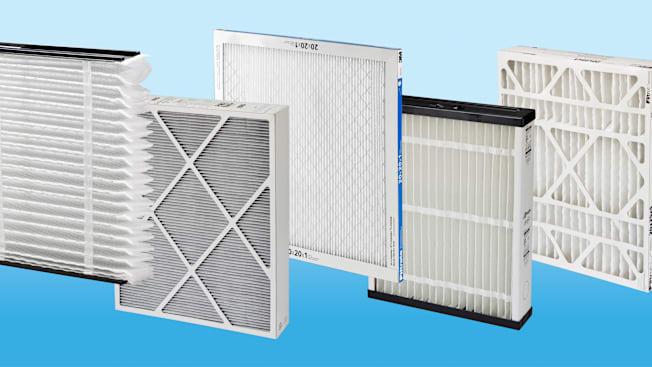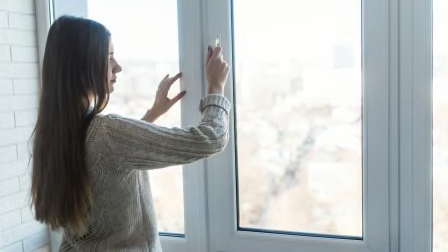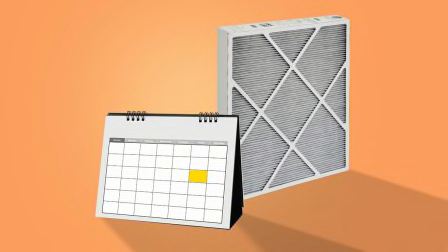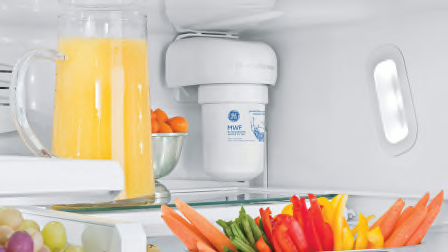Best Air Filters for Your Central AC and Furnace
Clean the air in your home and protect your HVAC system with one of these top-performing air filters from CR’s tests
When you shop through retailer links on our site, we may earn affiliate commissions. 100% of the fees we collect are used to support our nonprofit mission. Learn more.

The air filter in your HVAC system is something you probably don’t think about much because the unit is hidden away in your basement or attic. But a good air filter keeps your central air conditioner (and furnace) humming along by protecting it from dust and debris. The best filters trap indoor pollutants such as dust, pet dander, and pollen, helping to clean the air in your home so that it’s better for you to breathe.
That’s important because the concentration of air pollutants inside your home can be two to five times higher than concentrations typically found outdoors, according to the Environmental Protection Agency. An effective, snug-fitting HVAC filter can also help filter the air inside your home when air quality outdoors is poor, the EPA says.
In our tests, we gauge how well an air filter removes dust, pollen, and smoke from the air, and see how freely air flows through the filter at any fan speed. We also calculate the annual costs of replacement filters, based on the manufacturers’ recommendation for when to change them. (Keep in mind that prices may vary by retailer and that it may be cheaper if you buy filters in bulk.)
The relatively high annual price of smart filters is somewhat justified by their technology, which allows you to check the status of your filter from your smartphone to see if and when it needs replacing. However—unless you’re worried about needing to replace your filter early—you can also just set a calendar reminder for yourself to change out a regular filter and save some money.
“We find that thicker filters have two big advantages: They filter particles out of the air better and require replacement less often,” says Misha Kollontai, who oversees CR’s air filter testing. But not every HVAC system can accommodate a thicker filter—the most common size is 1 inch thick—though you can retrofit the ductwork of some systems to accept one.
Something else to keep in mind as you shop is the filtering grade given by the manufacturer. The most commonly used system applies a MERV number (minimum efficiency reporting value) to each filter, which was developed by ASHRAE (formerly the American Society of Heating, Refrigerating and Air-Conditioning Engineers). But 3M and Home Depot have developed their own classification systems called MPR (microparticle performance rating) and FPR (filter performance rating), respectively. “Both types of grading assign higher values to more effective filters, so when in doubt, go with a higher rating,” Kollantai says.
Don’t have a forced air HVAC system? You can still get some relief with a DIY air cleaner—we tested this popular social media hack in our lab.
Below are the top air filters from CR’s tests, grouped by thickness. For more information on air filters, including some models to avoid, see our full air filter ratings and air filter buying guide.
The Filtrete MPR 1900 is a 1-inch-thick air filter that’s impressive at removing dust, pollen, and smoke from the air when it’s running at its highest fan speed, though it’s only average at removing those same airborne particles at its lowest speed. Airflow through the filter remains strong in both instances. Filtrete recommends replacing this filter four times a year, so though the price is around $20 per filter, the annual cost can run to $80.
In our tests, the 1-inch-thick Filtrete Smart MPR 2200 does a fine job of removing airborne particles with the system running at its highest fan speed. However, at its lowest speed particular removal is less effective. Airflow through the filter, like with the Filtrete MPR 1900 filter, is strong in both instances. Filtrete recommends replacing this filter every four months, for an annual cost of about $120.
The Filtrete Ultra Allergen Reduction 1500 MPR filter is 1 inch thick and earns a very good rating for removing smoke, dust, and pollen from the air when the system runs on a high fan speed, but it’s only average when running on its lowest speed. In both cases, airflow through the filter is strong. Filtrete recommends changing this filter four times a year, for an annual cost of $68.
The 4-inch-thick Aprilaire Healthy Home 213 MERV 13 is excellent at removing dust, smoke, and pollen when the HVAC system is running at its highest fan speed. It does almost as well when running on its lowest fan speed, and air flows freely through the filter. Its annual cost is around $41 per year, based on Aprilaire’s recommendation to replace the filter once.
We also tested the 4-inch Aprilaire Allergy & Asthma 216 filter, which performs well and costs much more because it needs to be replaced twice a year.
The 5-inch-thick Lennox Healthy Climate CarbonClean 16 effectively filters dust, smoke, and pollen when the system is operating at both its highest and lowest fan speeds, with little noticeable restriction of airflow through the forced-air system. The list price for this filter is $100, and you’ll have to replace it only once a year.
Another good performer, the 4-inch-thick Filtrete MPR 1550 capably removes dust, pollen, and smoke with the HVAC system running on both its highest and lowest fan speeds, earning very good ratings. This filter provides nearly unrestricted airflow. Filtrete recommends that you replace this filter once a year, and at $29 per filter, that makes this a pretty cost-effective option.
The 5-inch-thick Carrier EZ Flex Filter Cabinet with a filtering rating of MERV10 earns a very good rating for removing dust, pollen, and smoke from the air when a system is running at its highest fan speed. However, it earns only a so-so rating with the HVAC running at the lowest speed. It has no problem maintaining airflow in either situation. Carrier recommends replacing this filter twice a year, for an annual cost of $128.







































